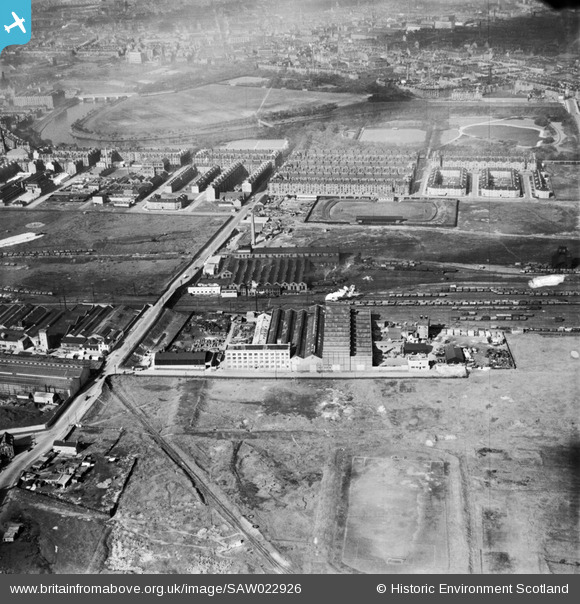SAW022926 SCOTLAND (1949). Glasgow, general view, showing Alley and MacLellan Ltd. Sentinel Works, Jessie Street and Glasgow Green. An oblique aerial photograph taken facing north.
© Copyright OpenStreetMap contributors and licensed by the OpenStreetMap Foundation. 2025. Cartography is licensed as CC BY-SA.
Details
| Title | [SAW022926] Glasgow, general view, showing Alley and MacLellan Ltd. Sentinel Works, Jessie Street and Glasgow Green. An oblique aerial photograph taken facing north. |
| Reference | SAW022926 |
| Date | 1949 |
| Link | NRHE Collection item 1269273 |
| Place name | |
| Parish | GOVAN (CITY OF GLASGOW) |
| District | CITY OF GLASGOW |
| Country | SCOTLAND |
| Easting / Northing | 259666, 662502 |
| Longitude / Latitude | -4.2410133010177, 55.83533242673 |
| National Grid Reference | NS597625 |
Pins

redmist |
Sunday 10th of January 2021 09:19:22 PM | |

redmist |
Sunday 10th of January 2021 09:17:25 PM | |

redmist |
Sunday 10th of January 2021 09:17:15 PM | |

redmist |
Sunday 10th of January 2021 09:13:40 PM | |

Billy Turner |
Wednesday 21st of October 2015 07:50:00 PM | |

Billy Turner |
Tuesday 6th of October 2015 08:57:20 PM | |

Billy Turner |
Tuesday 6th of October 2015 08:45:43 PM | |

Billy Turner |
Tuesday 6th of October 2015 08:09:06 PM | |

Billy Turner |
Monday 5th of October 2015 10:36:31 PM | |

Billy Turner |
Monday 5th of October 2015 10:34:52 PM | |

Billy Turner |
Monday 5th of October 2015 10:33:42 PM | |

Billy Turner |
Monday 5th of October 2015 10:20:43 PM | |

Billy Turner |
Monday 5th of October 2015 10:10:41 PM | |

Billy Turner |
Monday 5th of October 2015 09:52:57 PM | |

Billy Turner |
Monday 5th of October 2015 09:46:41 PM | |

Billy Turner |
Monday 5th of October 2015 09:31:02 PM | |

Billy Turner |
Monday 5th of October 2015 09:06:41 PM | |

Billy Turner |
Monday 5th of October 2015 08:47:11 PM | |

Billy Turner |
Monday 5th of October 2015 08:45:58 PM | |

Billy Turner |
Monday 5th of October 2015 07:35:12 PM | |

Billy Turner |
Monday 5th of October 2015 07:21:09 PM | |

Jim Howie |
Friday 31st of October 2014 10:29:31 AM | |

Class31 |
Sunday 9th of December 2012 09:38:01 PM | |

Class31 |
Sunday 9th of December 2012 09:36:43 PM | |

Class31 |
Saturday 8th of December 2012 09:01:56 PM | |

Class31 |
Saturday 8th of December 2012 09:01:00 PM | |

Class31 |
Saturday 8th of December 2012 09:00:35 PM | |

Class31 |
Saturday 8th of December 2012 08:59:27 PM |
User Comment Contributions
If I am to believe Wikipedia, Alley and MacLellan began life in Polmadie Glasgow in about 1875. In that same year a small town [3000 persons] Municipal Council in New Zealand at Oamaru, undertook the design of a very inovative public water supply system. See; http://www.panoramio.com/user/1283331/tags/The%20Oamaru%20Borough%20Race and http://www.ipenz.org.nz/heritage/itemdetail.cfm?itemid=2360 The design of this water supply involved the initial supply of many tons of lead and probably upwards of 100 specialised cast iron valves and fittings and about 1300 12' long x 21/2 foot diameter (600mm) cast iron pipes - of 7/8" wall thickness for the falling mains, the pipeline down into town from the reservoir in the hills behind the town. The contract for all this casting work was let to Anderson's Engineering and Foundry, Christchurch NZ but it was too big an order for them to supply and they outsourced to Alley and MacLellan. The pipes were deliveredstarting in 1879 and as two other falling mains eacj of 1300 or so pipes were required, further orders were placed for pipes in 1881 and 1883. The work must have been valuable to the company. Every pipe is marked on the bell with the company name and date and the wall thickness plus the customer's name OWW "Oamaru Water Works" something that would be unheard of today for standard cast iron pipes. all pipes would have been delivered to New Zealand to land at the fledgling harbour/port of Oamaru, by sailing ship and at this time I have no idea how they would have been off-loaded nor transported to 7km up into the hills for laying 4 feet below the surface. The three pipe lines are in service still and will be for the forseeable future. Any researcher interested in more detail may contact me at; guyro42@gmail.com. The video shows me sectioning a piece of the pipe to expose the leaded joint for public display. Bruce Comfort |

Bruce Comfort, New Zealand |
Wednesday 25th of June 2014 10:21:40 AM |


![[SAW022926] Glasgow, general view, showing Alley and MacLellan Ltd. Sentinel Works, Jessie Street and Glasgow Green. An oblique aerial photograph taken facing north.](http://britainfromabove.org.uk/sites/all/libraries/aerofilms-images/public/100x100/SAW/022/SAW022926.jpg)
![[SAW022927] Glasgow, general view, showing Alley and MacLellan Ltd. Sentinel Works, Jessie Street and Polmadie Road. An oblique aerial photograph taken facing north.](http://britainfromabove.org.uk/sites/all/libraries/aerofilms-images/public/100x100/SAW/022/SAW022927.jpg)
![[SAW022932] Glasgow, general view, showing Alley and MacLellan Ltd. Sentinel Works, Jessie Street and Polmadie Road. An oblique aerial photograph taken facing north.](http://britainfromabove.org.uk/sites/all/libraries/aerofilms-images/public/100x100/SAW/022/SAW022932.jpg)
![[SAW022933] Glasgow, general view, showing Alley and MacLellan Ltd. Sentinel Works, Jessie Street and Polmadie Road. An oblique aerial photograph taken facing north.](http://britainfromabove.org.uk/sites/all/libraries/aerofilms-images/public/100x100/SAW/022/SAW022933.jpg)













